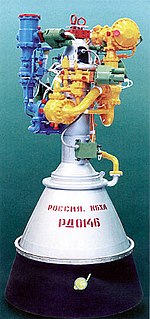RD-0146
 Model of RD-0146 | |
| Country of origin | Russia |
|---|---|
| Date | 2001 |
| Designer | KBKhA Design Bureau |
| Manufacturer | TsSKB Progress |
| Application | engine for KVTK upper stage |
| Liquid-fuel engine | |
| Propellant | LOX / LH2 |
| Cycle | Expander cycle |
| Configuration | |
| Chamber | 1 |
| Performance | |
| Thrust, vacuum | 68.6 kN (15,400 lbf) |
| Chamber pressure | 5.9 megapascals (860 psi) |
| Specific impulse, vacuum | 470 seconds (4.6 km/s) |
| Dimensions | |
| Length | 3.558 metres (11.67 ft) |
| Diameter | 1.95 metres (6 ft 5 in) |
The RD-0146 is a Russian cryogenic rocket engine. The RD-0146 engine was developed by KBKhA design bureau in Voronezh, Russia, in cooperation with the American Pratt & Whitney Rocketdyne company. In 2009, it came into prominence, as Russian space agency chose it for the second-stage of the proposed Rus-M launch vehicle designed to carry the future Russian PPTS crewed spacecraft.[1][full citation needed] After the cancellation of Rus-M rocket, the RD-0146D variant was selected as the powerplant for the KVTK upper stage.
Development
In 1999, Khrunichev requested KBKhA to develop RD-0146U version of the engine for Proton and Angara rockets. The development of the engine was partially financed by Pratt & Whitney Rocketdyne. Pratt & Whitney signed a preliminary marketing agreement on April 7, 2000 with Russia's Chemical Automatics Design Bureau giving Pratt & Whitney exclusive international marketing rights to the RD-0146.[1]
Description
The RD-0146 is the first Russian rocket engine not to feature a gas generator and to be equipped with extendable nozzle extension without a cooling system. The engine is capable of five firings and thrust control in two planes. According to the developer, the lack of a gas generator system ensures higher reliability of the engine for multiple firings, by removing the potential of an ignition failure in the engine power cycle.[citation needed]
See also
Comparable engines
References
External links
- KBKhA RD-0146
- RD-0146 Specifications
- RD-0146 description from Pratt & Whitney Rocketdyne [1]

